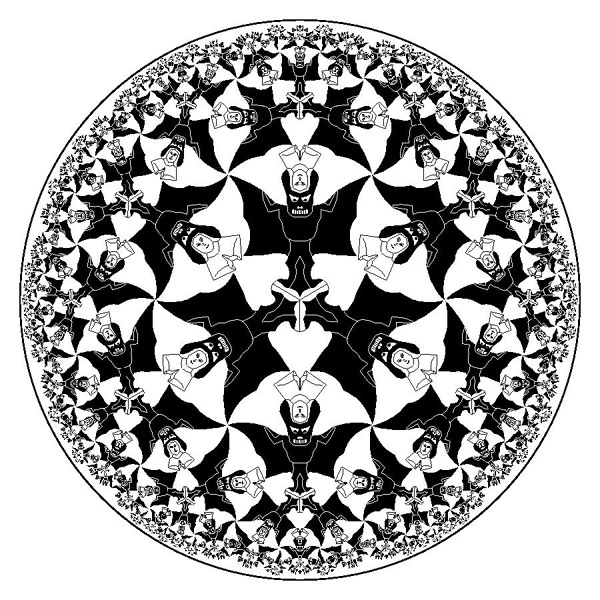Douglas Dunham |
"Fully Symmetric Angels and Devils"
Black and white print, 11" X 11", 2009.

This pattern is an "angels and devils" pattern in the styly of M.C.
Escher's print "Circle Limit IV". However, unlike Escher's print, all
the interior details of the angels and devils have been filled in,
giving the pattern 4-fold rotational symmetry about the wing tips of the
angels and devils in addition to the three reflection axes through their
feet. Thus the symmetry group of this pattern is 4*3 in orbifold
notation or [4+,6] in H.S.M. Coxeter's notation. We also note that
Escher's print only has D3 dihedral symmetry.
"Angels and Devils with *3333 Symmetry"
Gray-scale print 11" X 11", 2009.

This pattern adheres to the idea behind Escher's "angels and devils"
patterns that in some heavenly regions the angels should be dominant,
and in other hellish regions the devils should be dominant, and in
between, "earthly" regions angels and devils should hold equal sway. In
this pattern the angels have all their interior detail and the devils
have none (just black background) in the heavenly regions. The opposite
is true in the hellish regions. In the earthly regions, both the angels
and devils are shown with their interior details, but their background
is gray. There is no rotational symmetry about the wing tips, so the
symmetry group is *3333 in orbifold notation.
Doug Dunham, Professor of Computer Science
Department of Computer Science,
University of Minnesota Duluth
Freelance artist
Duluth, Minnesota, USA
The goal of my art is to create repeating patterns in the hyperbolic
plane. These patterns are drawn in the Poincare circle model of
hyperbolic geometry, which has two useful properties: (1) it shows the
entire hyperbolic plane in a finite area, and (2) it is conformal, i.e.
angles have their Euclidean measure, so that copies of a motif retain
their same approximate shape as they get smaller toward the bounding
circle. Most of the patterns I create exhibit characteristics of
Escher's patterns: they tile the plane without gaps or overlaps, and if
colored, they are colored symmetrically and adhere to the map-coloring
principle that adjacent copies of the motif are different colors. My
patterns are rendered by a color printer. Two challenges are to design
appealing motifs and to write programs that facilitate such design
and replicate the complete pattern.